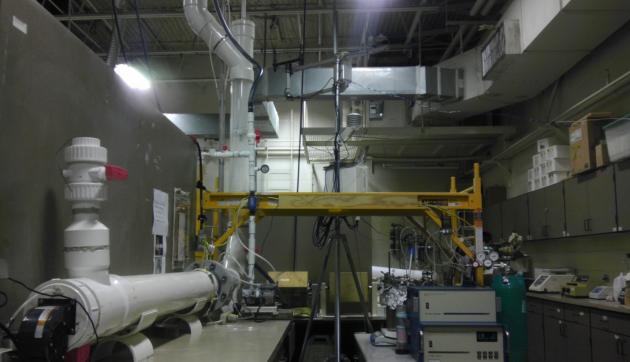![]() Waste to Worth home | More proceedings….
Waste to Worth home | More proceedings….
Abstract
The objective of this research was to evaluate electrolyzed water as a solution for a lab-scale spray scrubber for removing NH3 from air. A one-stage spray scrubber was fabricated to treat 50 cfm (1.42 m3/min) of introduced mixed NH3-air with an approximate NH3 concentration of 20 ppm. The mixed air was blown, countercurrent, to the 5-ft vertical scrubber body using a fan. Eight scrubber design variables were studied including contact times, nozzle types and scrubber solutions. Three contact times were 0.3, 0.6 and 0.9 s. The two narrow and standard nozzles sprinkled in a full-cone spray pattern but at different angles of 26ᴼ and 52ᴼ, respectively. The scrubber solutions variables tested were reverse osmosis (RO) water and two types of electrolyzed water (50 ppm of total chlorine) with pH = 9.0 and pH = 6.5. The 18 combinations of treatments were tested in three replications and statistically analyzed to investigate the objective. The result showed that all of the experiments were able to mitigate the NH3, but at different efficiencies. The maximum efficiency of 53% was acquired with the narrow nozzle, 0.9s contact time and electrolyzed water with pH = 6.5. Therefore, it was concluded that increasing the contact time, decreasing the pH of electrolyzed water and using the narrow angle, higher flow rate nozzle increased the scrubber efficiency.
 Ammonia scrubbing experiments conducted in three replications Ammonia scrubbing experiments conducted in three replications |
Why Study Ammonia Mitigation at Poultry Houses?
Ammonia (NH3) emissions from poultry houses are an environmental challenge because of the large volume of polluted ventilation air from the house’s exhaust fans. One idea for mitigation of NH3 was to developed and evaluate a lab-scale spray scrubber that used an electrolyzed water scrubber solution.

Lab-scale spray scrubber |
What Did We Do?
A one-stage spray scrubber was fabricated to treat 50 cfm of mixed NH3-air with approximate NH3 concentration of 20 ppm. The mixed air was blown, countercurrent, to the 5-ft vertical scrubber body using a regular fan and implemented 8 variables including contact times, spray types and scrubber solutions. Three contact times for about 0.3, 0.6 and 0.9 second were applied by changing the elevation of the spray stage. Also, two types of spray nozzles were studied to determine the effect of droplet size and the spray flow rate. The nozzles sprinkled in the pattern of a full-cone spray but in different spray angles; narrow and standard with 26ᴼ and 52ᴼ spray angle, respectively. The applied scrubber solution variables were reverse osmosis (RO) water and two types of electrolyzed water (50 ppm of total chlorine) with pH = 9.0 and pH = 6.5. Thus, 18 scenarios conducted in three replications and statistically analyzed to investigate the objective.
What Have We Learned?
The results showed that the scrubber in all experiments was able to mitigate the NH3 with different efficiencies. The efficiencies were averaged among the replications. The maximum efficiency of 56% was acquired by the narrow nozzle, 0.9s contact time and electrolyzed water with pH = 6.5 scenario. Therefore, it was concluded that increasing the contact time, decreasing the pH of electrolyzed water and the type of nozzle had increased the efficiency of the scrubber.
 Ammonia scrubbing experiments conducted in three replications Ammonia scrubbing experiments conducted in three replications |
Future Plans
After the electrolyzed water scrubber design and operating ranges are better understood from these laboratory studies, this technology will then need to be demonstrated under field operating conditions. Wet scrubbers designed based on knowledge gained from the laboratory studies can be placed in a trailer along with all necessary analysis equipment and moved to the site of an operating poultry building. Findings from this research could also be applied to many other types of animal production facilities.
Authors
Gerald Riskowski, Professor, Biological & Agricultural Engineering Department, Texas A & M University, riskowski@tamu.edu
Amir M. Samani Majd, PhD candidate, Biological & Agricultural Engineering Department, Texas A & M University
Ahmad Kalbasi, Researcher, Biological & Agricultural Engineering Department, Texas A & M University
Saqib Mukhtar, Professor, Biological & Agricultural Engineering Department, Texas A & M University
The authors are solely responsible for the content of these proceedings. The technical information does not necessarily reflect the official position of the sponsoring agencies or institutions represented by planning committee members, and inclusion and distribution herein does not constitute an endorsement of views expressed by the same. Printed materials included herein are not refereed publications. Citations should appear as follows. EXAMPLE: Authors. 2013. Title of presentation. Waste to Worth: Spreading Science and Solutions. Denver, CO. April 1-5, 2013. URL of this page. Accessed on: today’s date.

